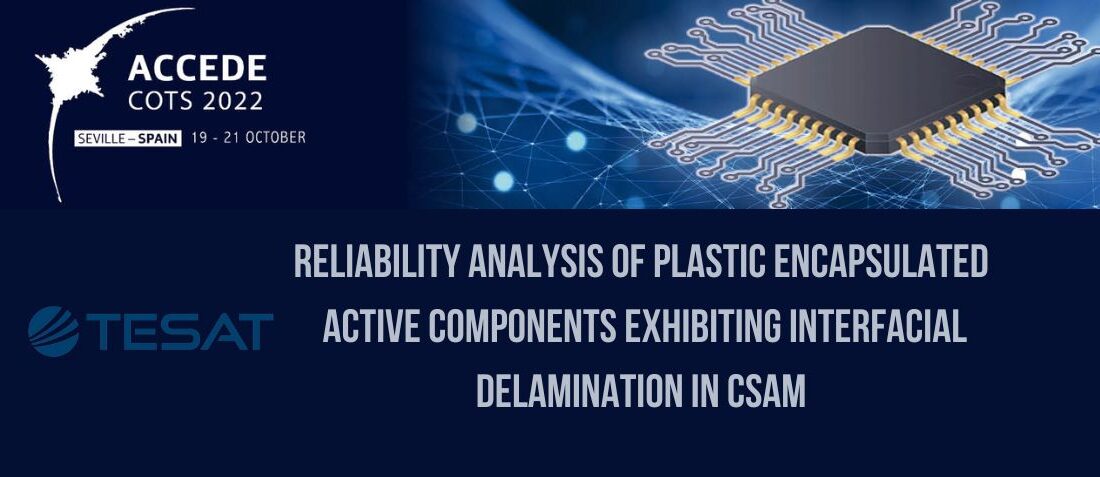
Reliability analysis of plastic encapsulated active components exhibiting interfacial delamination in CSAM
- Posted by doEEEt Media Group
- On August 1, 2023
- 0
New ideas for the use of Commercial Off Shelf (COTS) components
ABSTRACT
EEE plastic encapsulated devices are gaining wide acceptance due to their advantages is size, weight, cost, availability performance, are state-of-the-art. However, long-term reliability is influenced by its inherent structures and materials.
One of the most common package-related failure mechanisms for plastic encapsulated devices is interfacial delamination, meaning a disbonding between the surface of the plastic package and that of another material [1]. Delamination in packages is strongly related to the interfacial strength of two adjacent materials [3]. Depending on which material interface it occurred at, delamination does not necessarily lead to component failures directly. However, it has been identified or, at least, suspected to be the direct or indirect root cause for a multitude of reliability issues like the break or lifting of bond wires [4,5], cracking of the die [6], passivation cracking [7] or deterioration of the die attach [8] or popcorning.
To account for the above-detailed reliability risk, which is especially critical for space programs, ECSS-Q-ST-60-13C requires acoustic microscopy to check for delamination during the evaluation and the lot acceptance of components. Acoustic microscopy is a non-destructive imaging analysis technique capable of providing high-contrast images of void features inside plastic encapsulated devices.
ECSS-Q-ST-60-13C refers to JEDEC J-STD-020 as the test method and acceptance criteria for C-SAM. The corresponding test flow includes a so-called preconditioning iaw. J-STD-020 / JESD22-A113 that shall identify critical delamination. However, as specified in the standard, “passing the criteriaof the test method is not sufficient to provide assurance of long-term reliability.”
ESCC 25200 was introduced following the study “Introduction of Plastic Encapsulated Devices -(PED) into the ESCC system ” conducted by Bosch Telecom (now Tesat_Spacecom) under the DLR Contract 50 PS 9608 in the years 1996 – 1998. ESCC 25200 was then written in a follow-up CCN and published in the first issue in February 2001. Since then, only editorial changes have been made to this basic specification. In addition, the rejection criteria for delamination in ESCC 25200 are rather vague and, at the same time, strict.
For the reasons outlined above, searching for real-world data on the issue seems indicative. Quantitative data on COTS components currently on the market, however, is hard to find. In fact, in extended literature research already performed during the preparation of this study, we could only find very little data concentrated around ICs. Data on the reliability of PEC regarding delamination are not published.
The objectives of the study are to:
- Provide a comprehensive overview of the state of research
- Investigate the reliability impact of delamination in plastic encapsulated parts on delivery
- Find a quantitative correlation between the occurrence of delamination on delivery and
- electronic parameters drift up to failure
- Investigate the criticality of delamination occurring in different locations within the
- component and in different plastic packages geometries
The selection of components is based on previous experience in selecting PEC for space programs. Part types represent the range of parts typically present in electronic equipment for space missions, ranging between various packages and electric functions. Electrical measurements performed on each part type are focused on a limited set of key parameters.
Assembly simulation is included through performing J-STD-020 preconditioning. Thermal shock testing shall provoke failure with a large acceleration factor concerning typical thermal stress in a space mission [9]. To assess the progress of the damage, in between the thermal shock cycles, C-SAM is performed to investigate the parts for progressive delamination and for evidence of electrical parameter degradation up to catastrophic electrical failure. Depending on the speed of the onset of degradation, stress parameters are readjusted to yield a sufficient amount of damage to arrive at a meaningful analysis.
The study develops over the course of 12 months. The first analysis results are available after 3 months from the beginning of the study.

Speakers: Marcus Witzany & Federica Ferrarese – TESAT
Federica Ferrarese: Currently working in the EEE parts Engineering and Radiation department since October 2021. I’m responsible for all the topics related to Diodes and, in parallel, also part of the radiation team, supporting radiation testing and analysis of the results. I am also DLR technical advisor in the ECSS-Q-ST-60 Review Working Group. Previously I’ve been working for five years as Prime EEE Engineer at Airbus UK, in the last years mainly for New Space projects.
- Space-Grade components available for immediate delivery - April 10, 2025
- Managing EEE components for LEO and lower cost space missions - December 17, 2024
- Filtering Characteristics of Parallel-Connected Fixed Capacitors in LCC-HVDC - November 21, 2024


0 comments on Reliability analysis of plastic encapsulated active components exhibiting interfacial delamination in CSAM